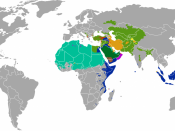Before Muhammed's birth the Middle East already had many years of experience under its belt. From Mesopotamia all the way to nomadic Arabs settlings into towns and eventually cities, the people of the Middle East had already begun carving out its history long before the Prophet. This abundance of culture, though, which was left behind as each empire rose and fell, was not simply paved over and replaced by Islam. The Islamic culture, whether consciously or not, pick and chose from the pre-Islamic culture to help create its own traditions and values. The three biggest influences on Islamic culture were: existing Judaism and Christianity, the Sasanid Persia Empire, and pre-Islamic Arabs.
Judaism and Christianity are believed, by Muslims, to be ahle kitaab or "by the book". These religions are also right in the eyes of God but have strayed from his word in one aspect or another. Therefore, Muhammed was able to adapt many traditions from existing ahle kitaab culture.
From Judaism Muhammed adapted the fast on Yom kippur and the Jewish Sabboth, both of which were eveolved as Islam developed, the fast on Yom Kippur became thirty days of fasting for Ramadan and the Sabboth became a Friday sermon. Muhammed taught that Jesus and Moses are also Prophets and that they too should be venerated by the Muslims. Muhammed claimed that Judaism, Christianity and Islam were all meant to be one religion, but corruption led to the need and split of the ahle kitaab into three distinct sections. One can infer then, that all aspects in the prior religions that had been preserved from the debauchery should apply to Islam as well.
The second large scale influence on Islam was the Sasanid Persia. The Sasanid Lakhmids established the societal and traditional principles that are present to this day...


